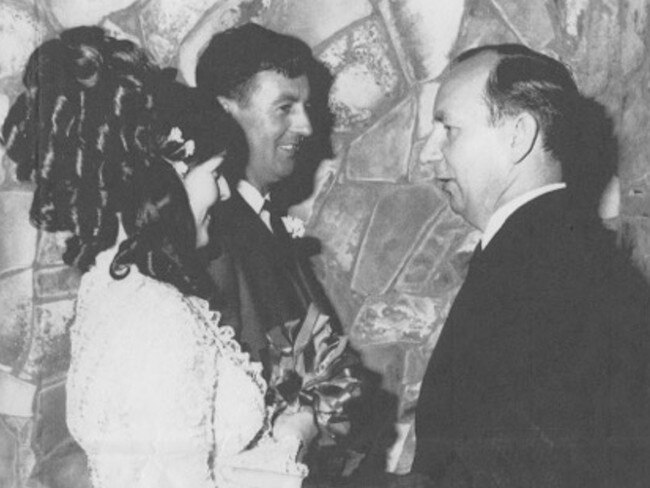Convict Artisans in Exile exhibition highlights skills of crafty crims
A new exhibition shines a spotlight on the incredible, and usually unsung, talents of our convict artisans whose valuable skills helped forge a new society.

Sydney Weekend
Don't miss out on the headlines from Sydney Weekend. Followed categories will be added to My News.
The big grandfather clock made from Australian cedar chimes beautifully on the hour in the stair hall of Parramatta’s Old Government House. It keeps perfect time, despite being 200 years old.
The seven-foot (2.1m) case clock was made by convict James Oatley who was sentenced to life in 1817 for stealing a large amount of fabric in England.
The clock, made for ex-convict-turned landowner Thomas West and on loan to the National Trust from the West family, is one of about 40 items in an exhibition called Making Good: Convict Artisans in Exile.
National Trust assistant curator of Parramatta Properties, Anna Ridley, hopes the exhibition will show that not all convicts who came to NSW were worthless criminals and that many came with valuable skills that in many ways helped establish the new society.
“We know that people were not being sent to Sydney based on their skills, it was a fluke rather than good management that some of the convicts that arrived had valuable skills to share,” she says.
“A lot of these convicts were affected by the industrial revolution back home which was affecting their jobs.
“Some were skilled artisans who were trying to feed and house their families and turned to crime to make ends meet.”

There’s the story of potter Jonathan Leak who had his own business in Staffordshire but had tried many times, unsuccessfully, to sell it between 1810 and 1814. In 1819 he was charged with stealing £300 and sent to Sydney where he was assigned to the government pottery.
A few years later he received his ticket of leave plus two land grants in Surry Hills where he set up his own pottery business which, within a few years, employed 20 men.
His wife Mary and their four children joined him after he received his ticket of leave and his eldest son Lewis brought with him pottery moulds used in the manufacture of pipes and jugs to further the family business.
A beautiful vase believed to be made by Leak is part of the exhibition.
“A lot of the skilled convicts did better here than they would have if they stayed back home in England,” Ridley says.
“In fact, I sometimes wonder if some of them weren’t trying to get transported to start a new life.
“This seems to me like it could be the case for James Oatley, who made the grandfather clock. He was initially charged with stealing a tonne of cheese and served several years on a hulk before being pardoned. Then he stole a large amount of fabric and was sent to Sydney.
“He was an established clockmaker already.”
Two years after arriving in Sydney, Oatley was appointed Keeper of the Town Clock and later, Keeper of the St James Clock. His business flourished and he was granted land in the city and the Hurstville area.
Among the more delicate pieces in the exhibition are the lace collars made by Susannah Lilliment, who was charged with stealing £10 from her employer and sentenced to life, arriving in Sydney in 1815.
She married Aaron Walters and the pair set up a home on the Macdonald River in the Hawkesbury where they ran the area’s first inn. Susannah was from a family of lacemakers and she made some beautiful needle run lace pieces by hand as she did not have the machinery to produce it otherwise.
Another piece featured is a ceremonial chair created by carpenter William Temple, sentenced to life for larceny in 1814 but assigned as a carpenter to Governor Lachlan Macquarie at Government House.

And then there’s First Fleeter James Bloodsworth, transported for stealing poultry but responsible for the design and construction of the first substantial houses in the colony, including the original Government House.
Making Good: Convict Artisans in Exile is on at Old Government House, Parramatta, until November 27
Got a local history story to share? Email mercedes.maguire@news.com.au
FINE ART OF FINDING TROUBLE
Joseph Backler was sentenced to life for forging cheques, arriving in Sydney in 1832. While he had obvious skill as an artist, Backler was constantly in trouble in the colony. But he received his ticket of leave in 1842 and advertised his services as an artist to wealthy businessmen and their families.
His success didn’t stop him from being embroiled in scandal in 1850 when he tried to pass off a copy of a Titian as an original work in an art competition. His painting titled Mrs Frederica Mary Josephson, circa 1855, is part of the exhibition.
PARRAMATTA’S COUNTRY RETREAT
Constructed between 1799 and 1820, Old Government House served as the country residence of the first 10 governors.
The Georgian building located in Parramatta Park and overlooking the Parramatta River is the oldest surviving public building in Australia and one of 11 Australian convict sites listed on the UNESCO World Heritage Register.
Today, Old Government House is furnished in the style of the 1820s, the decade it was completed, and is home to the National Trust’s premier colonial furniture collection.
Wayside Chapel‘s ‘inclusive’ wedding legacy
The bride wore a non-traditional white sari down the aisle with a jewelled bindi at the centre of her forehead. Her groom waited for her in a matching white tunic. Brightly-coloured fresh flower garlands hung from their necks and a pink poodle pranced around at their feet.
Chandor Ponnusamy was a Hindu and Dell, a Christian, when they married at the Wayside Chapel in 1969 in a grand ceremony that included a serenade by 1960s Malaysian singing sensation, Kamahl.
In a time before celebrants married people in the park or on the beach, mixed-faith couples who were turned away from traditional churches had little option as to where they could tie the knot.
Reverend Ted Noffs and the little Wayside Chapel at Kings Cross was, for many marginalised couples, the only option for a legal marriage.
And between 1964 and 1986 it is said Reverend Noffs married about 24,000 couples from 132 different nations, sometimes at a rate of one every half-hour on weekends.


The couples were a mixture of those who had been turned away from marrying in traditional churches – mixed-faith couples or those where one was a divorcee – and those who supported the vision of Noffs and what he was doing at Kings Cross.
It’s the subject of a new play called Wayside Bride developed by Sydney playwright Alana Valentine and now on stage at the Belvoir St Theatre in neighbouring Surry Hills.
Valentine’s own mother, Janice Powell, married second husband Roy at the Wayside Chapel in the 1970s because, as a divorcee, she wouldn’t have been able to marry in a church.
Her mother’s story is one of the few Valentine included in the new play; many others, like the Ponnusamys’, which she researched but couldn’t include due to time constraints, are part of a display that will be shown in the foyer.
“I think a lot of people have heard of the Wayside Chapel but not a lot of people know much about it,” Valentine says.
“Even today when people hear that a couple were married there they say things like ‘but isn’t it just a homeless shelter?’ People don’t realise there were baptisms, weddings and funerals done there and there is still a weekly Sunday service there.
“When you think about the times, like the 1960s and 1970s, when there were no celebrants, if you wanted to be married in a church your options were limited.
“Matt Noffs, Ted’s grandson who runs the Noffs Foundation, said the Wayside Chapel was the ‘only show in town’ for people who couldn’t be married in a church.”

Another story Valentine researched was that of Ursula Zuffo who unknowingly married a bigamist in the 1960s. Years later when she wanted to remarry, she had to prove her first marriage was not legal.
The only way she could do this was by finding the bigamist’s first and only legal wife – it turns out he had married around 12 women – and provide her marriage certificate as proof that her own could therefore not have been legal.
Ursula married Sergio Zuffo at the Wayside Chapel in 1969.
“I found most of the people who were married there were really proud of being married at Wayside because they supported Noffs’ vision of inclusivity,” Valentine says.
“Ted Noffs was a maverick of the Methodist church and he was called up a few times to account for what he was doing at Wayside but he was never ejected from the church. In 1975, he received a letter asking him to address a committee on a charge of unfaithfulness, which was really a charge of heresy, but he was ultimately found not guilty.”

Valentine says Noffs’ wife, Margaret, was a steadfast supporter of her husband’s work at the Wayside Chapel, though she shunned the limelight. She died in December 2021, aged 95, and Valentine has dedicated the play to her. Ted Noffs died in 1995.
Wayside Bride is on now at the Belvoir St Theatre, and will run until May 29.
Got a local history story to share? Email mercedes.maguire@news.com.au
COMMUNITY AND CONNECTION
The Reverend Ted Noffs opened the Wayside Chapel in April 1964 in a few rooms in a block of apartments in Kings Cross with a vision that focused on community and connection.

The Methodist parish mission grew quickly to include a chapel, coffee shop, crisis centre, the first office of the Foundation for Aboriginal Affairs and a theatre.
Thousands of people were married at the chapel, including US film star Jane Powell, ironically of Seven Brides For Seven Brothers fame, and Andy Gibbs of the Bee Gees.
Reverend Noffs died in 1995. Today, the Wayside Chapel is part of the Uniting Church.
MARRIAGE BY THE NUMBERS
Covid has had a very real impact on marriages performed with a 30 per cent drop in couples tying the knot from 2019 to 2020, according to the Australian Institute of Family Studies.
Marriages hit an all-time high in 1942 when the crude marriage rate (number of marriages per 1000 people) registered 12, compared with three in 2020. And the number of ceremonies performed by a minister of religion, not a civil celebrant, dropped from a high of 98 per cent in 1902 to just 20 per cent in 2020.





